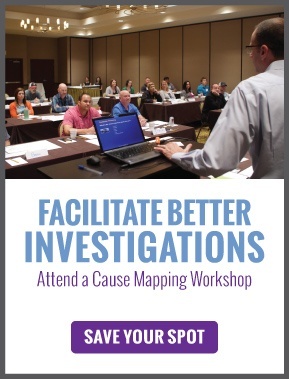Facilitation FAQs
“What do I need to begin an investigation?”
Typically, the first things to establish are the communication requirements between you (the client) and us (ThinkReliability). This may include sending you a quotation for our services, establishing a non-disclosure agreement, and/or attorney client privilege requirements as required.
This process may be initiated by accessing our Quote Request webpage or by simply calling or texting me. (Yes, it’s that simple.)
“What should I send to start an investigation?”
Once we’re able to exchange information, we’d like to see anything that you’ve collected. Most of the time the initial information gathering includes (but is not limited to): incident reports, photos, witness statements, timelines, and/or starting to fill in the Excel Cause Mapping template.
“So then we get 15 people in a room, right?”
Once a project is ready to be kicked off, our remote facilitators will set up a meeting (a dial in number and screen-sharing link) to be distributed to the required attendees. We typically recommend a "core-team" of 4-6 people that participate through the investigation. We can pull in others as required but too many people tends to become distracting and perhaps an ineffective use of everyone’s time.
As the facilitator gets up to speed on the incident (which may require some one-on-one discussions), action items will be identified where more information is required to complete the investigation. As these action items are completed, the Excel file is updated and the team reviews each iteration and provides any missing information.
This iterative process continues until the team determines the level of detail is sufficient to identify effective solutions.
“What if I need you onsite RIGHT NOW (or yesterday)?”
We understand that some incidents are high priority and require immediate attention. Once the area /system has been stabilized and the incident has been immediately responded to, the best thing to do is begin the Cause Map Excel file to document what happened, when, where, etc. This will assist in identifying evidence that may need to be collected and/or preserved.
We may need to come onsite, but this is not generally where we provide the most value. The reason: there is a lot going on during initial containment of a large incident (as you may have experienced). People are typically spread thin with tasks on top of their regularly assigned duties. This tends to delay the beginning of a formal kickoff for investigations. However, we highly suggest to utilize this opportunity to begin to document the incident in the background until we can get the team together.
How much does a facilitation cost?
More questions?
I hope this helps you understand the facilitation process and what to expect when you’re expecting a facilitation. Please don’t hesitate to contact us with further questions or concerns with the facilitation process, or email me directly at renata.martinez@thinkreliability.com











